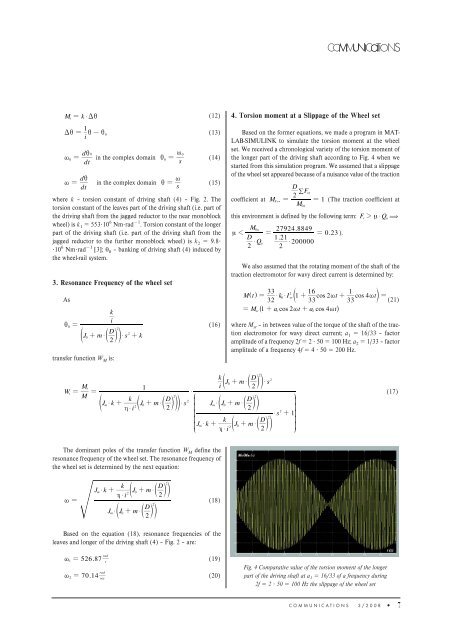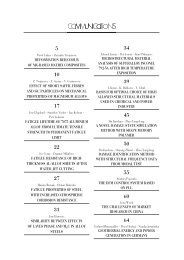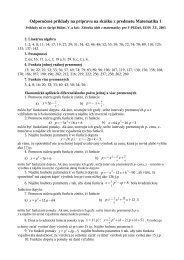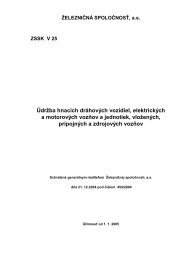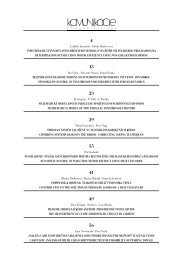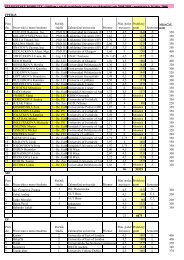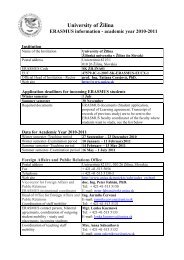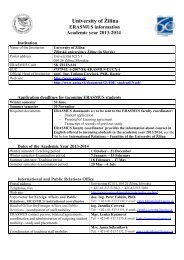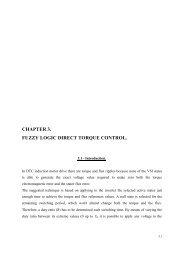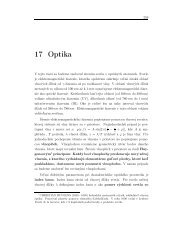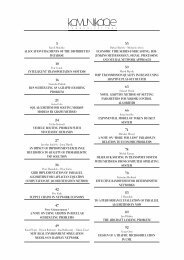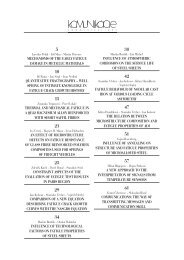simulation of torsion moment at the wheel set of the railway vehicle ...
simulation of torsion moment at the wheel set of the railway vehicle ...
simulation of torsion moment at the wheel set of the railway vehicle ...
You also want an ePaper? Increase the reach of your titles
YUMPU automatically turns print PDFs into web optimized ePapers that Google loves.
Mt = k$ Di(12) 4. Torsion <strong>moment</strong> <strong>at</strong> a Slippage <strong>of</strong> <strong>the</strong> Wheel <strong>set</strong>1D i = i-i i0di0~ 0 =dt(13)~ 0in <strong>the</strong> complex domain i0=(14)sdi~~ = in <strong>the</strong> complex domain i =(15)dtswhere k – <strong>torsion</strong> constant <strong>of</strong> driving shaft (4) – Fig. 2. The<strong>torsion</strong> constant <strong>of</strong> <strong>the</strong> leaves part <strong>of</strong> <strong>the</strong> driving shaft (i.e. part <strong>of</strong><strong>the</strong> driving shaft from <strong>the</strong> jagged reductor to <strong>the</strong> near monoblock<strong>wheel</strong>) is k 1 55310 6 Nmrad 1 . Torsion constant <strong>of</strong> <strong>the</strong> longerpart <strong>of</strong> <strong>the</strong> driving shaft (i.e. part <strong>of</strong> <strong>the</strong> driving shaft from <strong>the</strong>jagged reductor to <strong>the</strong> fur<strong>the</strong>r monoblock <strong>wheel</strong>) is k 2 9.810 6 Nmrad 1 [3]; θ 0 – banking <strong>of</strong> driving shaft (4) induced by<strong>the</strong> <strong>wheel</strong>-rail system.3. Resonance Frequency <strong>of</strong> <strong>the</strong> <strong>wheel</strong> <strong>set</strong>Asi =0kiJ m D 2e0 + $ d n o $ s + k2transfer function W M is:2(16)Based on <strong>the</strong> former equ<strong>at</strong>ions, we made a program in MAT-LAB-SIMULINK to simul<strong>at</strong>e <strong>the</strong> <strong>torsion</strong> <strong>moment</strong> <strong>at</strong> <strong>the</strong> <strong>wheel</strong><strong>set</strong>. We received a chronological variety <strong>of</strong> <strong>the</strong> <strong>torsion</strong> <strong>moment</strong> <strong>of</strong><strong>the</strong> longer part <strong>of</strong> <strong>the</strong> driving shaft according to Fig. 4 when westarted from this <strong>simul<strong>at</strong>ion</strong> program. We assumed th<strong>at</strong> a slippage<strong>of</strong> <strong>the</strong> <strong>wheel</strong> <strong>set</strong> appeared because <strong>of</strong> a nuisance value <strong>of</strong> <strong>the</strong> tractioncoefficient <strong>at</strong>D/ F ot2= = 1 (The traction coefficient <strong>at</strong>Mthis environment is defined by <strong>the</strong> following term: F 2 n $ QM0n27924.8849n 1 = = 023 . ).D 121 .$ Q a $ 2000002 2We also assumed th<strong>at</strong> <strong>the</strong> rot<strong>at</strong>ing <strong>moment</strong> <strong>of</strong> <strong>the</strong> shaft <strong>of</strong> <strong>the</strong>traction electromotor for wavy direct current is determined by:33 2 161Mt ^ h = $ k0$ Isrd1+ cos 2~ t+ cos 4~tn=3233 33(21)= M ^1+ a cos 2~ t+a cos 4~thsrMFv)0n1 2v a (where M sr – in between value <strong>of</strong> <strong>the</strong> torque <strong>of</strong> <strong>the</strong> shaft <strong>of</strong> <strong>the</strong> tractionelectromotor for wavy direct current; a 1 16/33 – factoramplitude <strong>of</strong> a frequency 2f 2 50 100 Hz; a 2 1/33 – factoramplitude <strong>of</strong> a frequency 4f 4 50 200 Hz.Mt1Wt= =MkJ k J m D 2f m $ + es2 0 + $ d n op $h $ i 222k D J m2e0 + $ d n o $ si 2$JJ J m D 2Km $ e0 + $ d n oK2KkJ k J m D$ s2KK m $ + e2 0 + $ d n oh $ i 2L2NOO+ 1OOOP(17)The dominant poles <strong>of</strong> <strong>the</strong> transfer function W M define <strong>the</strong>resonance frequency <strong>of</strong> <strong>the</strong> <strong>wheel</strong> <strong>set</strong>. The resonance frequency <strong>of</strong><strong>the</strong> <strong>wheel</strong> <strong>set</strong> is determined by <strong>the</strong> next equ<strong>at</strong>ion:~ =kJ k J m D2m $ + e2 0 + $ d n oh $ i 2J J m D2m $ e0 + $ d n o2(18)Based on <strong>the</strong> equ<strong>at</strong>ion (18), resonance frequencies <strong>of</strong> <strong>the</strong>leaves and longer <strong>of</strong> <strong>the</strong> driving shaft (4) – Fig. 2 – are:~ 1 = 526.87 sradrad~ 2 = 70.14 sec(19)(20)Fig. 4 Compar<strong>at</strong>ive value <strong>of</strong> <strong>the</strong> <strong>torsion</strong> <strong>moment</strong> <strong>of</strong> <strong>the</strong> longerpart <strong>of</strong> <strong>the</strong> driving shaft <strong>at</strong> a 1 16/33 <strong>of</strong> a frequency during2f 2 50 100 Hz <strong>the</strong> slippage <strong>of</strong> <strong>the</strong> <strong>wheel</strong> <strong>set</strong>COMMUNICATIONS 3/2008 ●7


